 |
|
Fu displays her tapestry to tourists. Her intricate embroidery work and one of her dragon-themed double-sided tapestries. [Photo provided to China Daily] |
"When Ding Dang is able to understand more, I will tell her stories about the Li people and the brocade, prized tributes to the royal palace ever since the Han Dynasty (BC 206-AD 220)," said the proud grandmother.
Fu's potential encouragement for her granddaughter is in marked contrast to her approach to her elder daughter Fu Lirong. When her daughter told her that she would like to learn the traditional skills after graduation in 2008, Fu spurned the idea.
"I know how hard the job is for a woman and what was more depressing was that at the time I did not see a future for someone to follow that path," said Fu.
The Li ethnic group accounts for about 1.3 million people, and around 90 percent live on the island. Fu learned the traditional skills from her grandmother but it seemed to be a dying art due to social development and the introduction of modern textiles.
The number of people classified as masters of brocade techniques plunged from 50,000 in the 1950s to around 1,000 about 10 years ago.
"We display our ethnic history by embroidering symbolic designs on the colorful Li cloth. It's like a 'historical book"', Fu explained.
"In 2006 I lost my job as a grain store worker in Baisha Li autonomous county, my hometown. Worse, my husband passed away, leaving our two daughters. I had to shoulder the family burden myself," said Fu.
"I turned to my aunt for help. She was a master of embroidery and encouraged me to pick up and pass on the traditional skills. Under her guidance, I mastered the four basic skills for brocade making-spinning, dyeing, weaving and embroidery, a complete set of highly complicated techniques which very few have mastered," said Fu.
The time spanning 2006 to 2008 were the hardest years and she slept for just two or three hours a day to devote enough time for weaving and embroidery.
But the hard work and devotion paid off.
"A young man, who was intrigued by Li brocade at an exhibition in the United States, came to Baisha in 2013 especially for one of my double-sided tapestries. It depicted the landscape of the local Beauty Mountain," said Fu. She sold it for 68,000 yuan and the money gave her the confidence and freedom to continue her work.
Fu said she was impressed by the efforts of the Hainan government to save the techniques.
|
|
|
|
|
|
|
|
